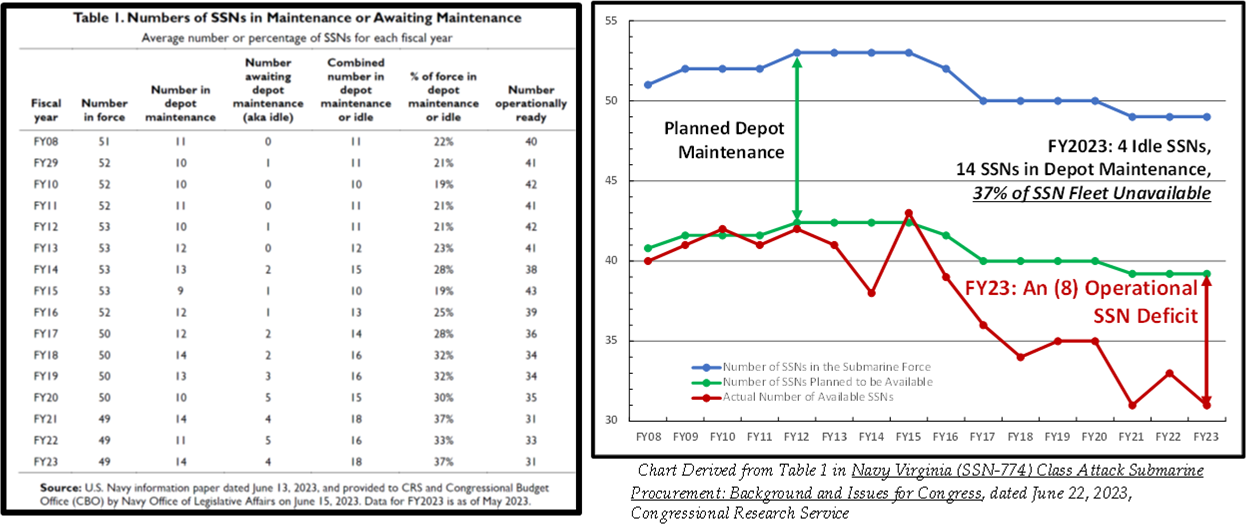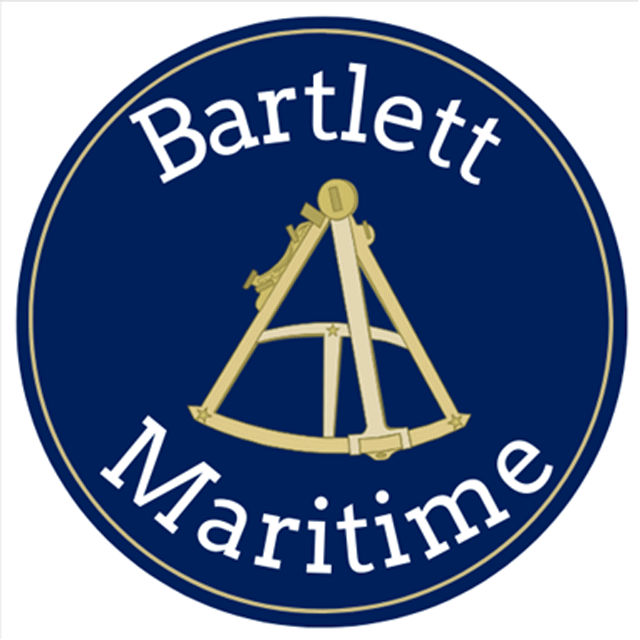Bartlett Maritime Corporation is pleased to release details of its Bartlett Maritime Plan™.
Following the public release of the June 22, 2023, Congressional Research Service (CRS) Report, there has been significant national press attention to the realization that, as reported by CRS, 37% of the US Navy’s nuclear powered attack submarine (SSN) force is unavailable for operation due to long term maintenance. Data from this CRS Report is shown below in both its original Table format and as a graph. Note that the trend line is adverse – going the wrong way. Given this heightened public and press interest, the company has elected to release details of its plan to immediately and affordably address this crisis.

Numbers of SSNs in Maintenance or Awaiting Maintenance
The Bartlett Maritime Plan™ has been developed over the last several years at no cost to the government to address and resolve this pernicious National Security crisis.
On June 19, 2023 the company submitted to the US Navy an update to its existing, unanswered unsolicited proposal, originally submitted January 21, 2022, to conduct Phase 1 Planning, Research and Concept Demonstration activities required to initiate plan execution. This update reflects the continuing, extensive company-funded plan development which has occurred over the 514 days between the initial submittal of this unsolicited proposal and submittal of the update. For context, during the Cold War USS Casmir Pulaski (SSBN 633), a nuclear powered ballistic missile submarine, was built in only 580 days (from laying the keel to ship commissioning into service). It is, as validated in the CRS Report, well past time to move beyond “thinking about it” and into action to implement the only readily actionable plan which addresses the underlying industrial base capacity and capability issue.
The Bartlett Maritime Plan™: An Innovative and Affordable Solution
Proposed Industrial Facilities: A Strategic Response
The Bartlett Maritime Plan™ proposes the development and construction of new industrial facilities to augment existing submarine maintenance capacity and capability, takes advantage of experienced trades resources, and solves the ever-looming funding issue. The plan is mature, readily actionable, affordable and led by experienced shipbuilders and maintainers.
The proposed Component Repair Center (CRC) facilities, which are in close proximity to east coast shipyards and logistically well-connected to support the west coast shipyards, will serve as baseline capabilities to begin addressing the attack submarine availability crisis. These facilities include:
· CRC – Lorain. Construction of a ship component overhaul, repair, remanufacturing, and testing facility, to be built on a brownfield site located in Lorain, OH.
· CRC – Lordstown. Construction of a ship component and equipment rotatable pool and material stocking and kitting facility to be built on a greenfield site located in Lordstown, OH.
· CRC – Foundry. Acquisition, modernization, and installation of forge equipment at an existing highly specialized foundry located in a selected but publicly unspecified location.
The development and operation of these new industrial facilities targets bottlenecks in current maintenance processes and is anticipated to shorten typical 2-year SSN overhauls by 100 days each. The collateral and cascading benefit is the depressurization of shipbuilding schedules for both new Virginia Class SSNs, the new Columbia Class Ballistic Missile submarines, and the proposed next generation SSN(X), with relief coming as soon as 6-months following contract award and full capability of the proposed facilities within 2 years. This program is both completely scalable, as discussed below, and offers benefits expandable to other ship classes.
A Fifth Naval Shipyard is Included as a Program Option
Once the CRC facilities are established and the funding and oversight regimes are proven, the Bartlett Maritime Plan™ provides a follow-on option for a much needed fifth Naval Shipyard in Charleston, SC. This new, advanced design shipyard is site-ready at the Naval Weapons Station in Goose Creek and could begin construction as early as 2024. With immediate focus on the implementation of the CRCs, their success targets more immediate relief while validating the funding and labor model for follow-on efforts.
Supply of Experienced Trades Labor to Meet Capacity and Capability Needs
The selection of Ohio for the CRCs is strategic, taking advantage of the relatively close proximity to east coast shipyards (overnight drive), strong logistic connection to west coast shipyards and robust available labor pool along the Great Lakes. Possessing 128% of the required skilled trades, this labor pool is largely idle or underemployed (for now) and is eager to apply their skills to submarine maintenance and repair. Shared with Navy leadership, this labor plan is also scalable and reproducible to support the development of follow-on, more expansive opportunities, such as the new Charleston Naval Shipyard option mentioned above.
An Innovative and Unique Funding Plan
We must assume a constrained Navy budget “top line” given historical DoD funding splits and increasing budgetary pressures as a result of the Fiscal Responsibility Act of 2023. The Bartlett Maritime Plan™, developed with advice from our investment bankers at Goldman Sachs and our attorneys at Squire Patton Boggs, leverages existing law and regulations to allow access the capital markets to bring this opportunity to the U.S. Navy. As an added benefit, and over an agreed amortized period, the Navy will then own the facilities via an authorized but never before utilized provision in federal law enabling long-term lease-purchases for this type of facility. Said another way, already oversubscribed Navy military construction (MILCON), shipbuilding (SCN), and operations (O&MN) budgets are all protected, and these facilities become entirely affordable within Federal budget restrictions.
Critical to the successful execution of the Bartlett Maritime Plan™ is the partnership and collaboration with the four public Naval Shipyards mentioned above, the private yards at Electric Boat and Newport News and other stakeholders in the Submarine Industrial Base. The aim is to form a united front in addressing the submarine maintenance crisis, pooling expertise and resources to achieve collective success.
Bartlett Maritime Corporation is ready to execute on its groundbreaking Bartlett Maritime Plan™ and to quickly move forward with its plan to significantly improve the capacity and capability of the nuclear-powered US Navy ship and submarine industrial base.
Commenting on the public release of this plan, Chairman and CEO CAPT Edward L. Bartlett, Jr. noted, “This transformative, mature, low-risk and immediately actionable plan meets the moment. Just as I am confident that US Navy leadership is going to act near-term to provide us an opportunity to demonstrate our plan in action, I am confident in the experience, capability, grit, determination, and commitment of every member of our team to successfully support the Navy in resolving this crisis. We stand ready to deliver for our Navy and our Nation.”

